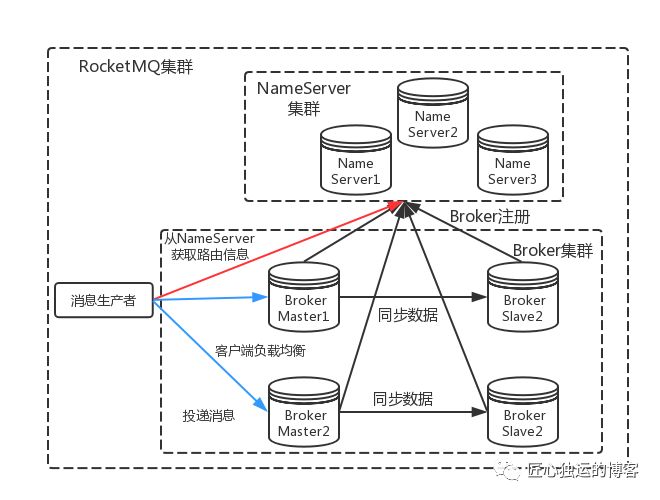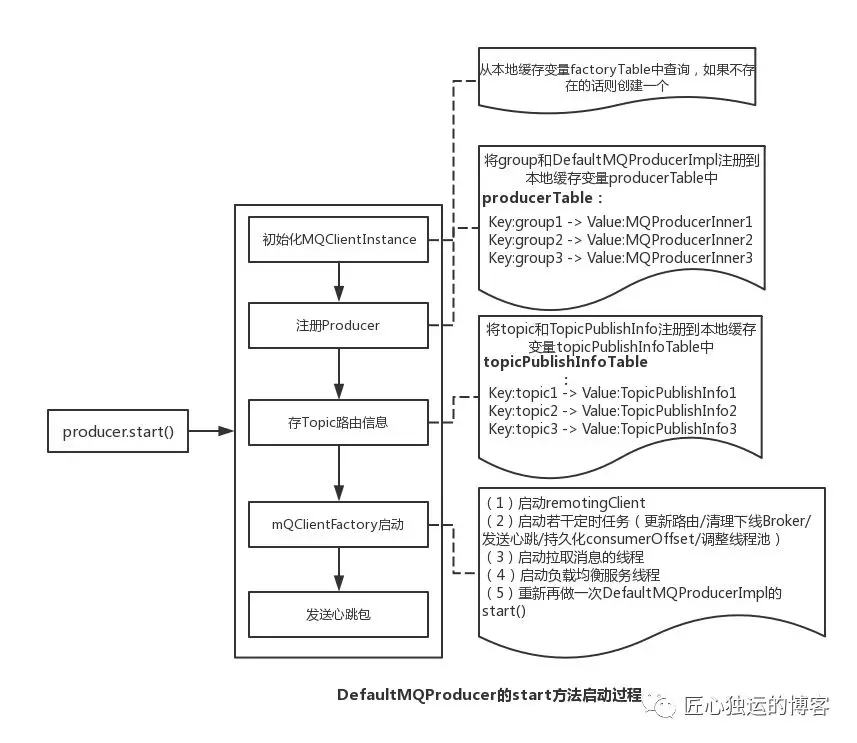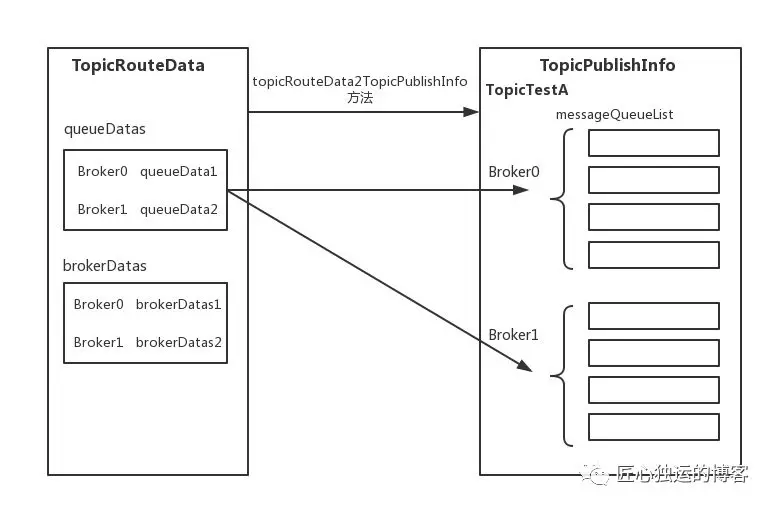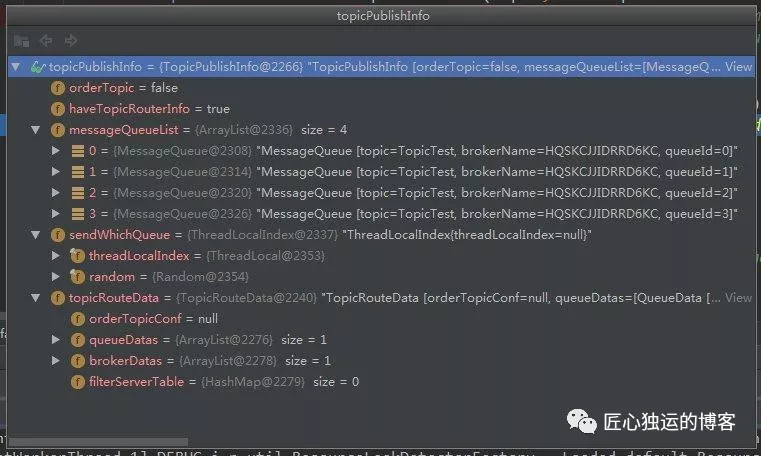消息中间件消息发送
大道至简,消息队列可以简单概括为:“一发一存一收”,在这三个过程中消息发送最为简单,也比较容易入手,适合初中阶童鞋作为MQ研究和学习的切入点。因此,本篇主要从一条消息发送为切入点,详细阐述在RocketMQ这款分布式消息队列中发送一条普通消息的大致流程和细节。在阅读本篇之前希望读者能够先仔细读下关于RocketMQ分布式消息队列Remoting通信模块的两篇文章:
http://www.6aiq.com/article/1563128272857
http://www.6aiq.com/article/1563128435731
一、RocketMQ网络架构图
RocketMQ分布式消息队列的网络部署架构图如下图所示(其中,包含了生产者Producer发送普通消息至集群的两条主线)
 对于上图中几个角色的说明:
对于上图中几个角色的说明:
(1) NameServer:RocketMQ集群的命名服务器(也可以说是注册中心),它本身是无状态的(实际情况下可能存在每个NameServer实例上的数据有短暂的不一致现象,但是通过定时更新,在大部分情况下都是一致的),用于管理集群的元数据( 例如,KV配置、Topic、Broker的注册信息)。
(2) Broker(Master):RocketMQ消息代理服务器主节点,起到串联Producer的消息发送和Consumer的消息消费,和将消息的落盘存储的作用;
(3) Broker(Slave):RocketMQ消息代理服务器备份节点,主要是通过同步/异步的方式将主节点的消息同步过来进行备份,为RocketMQ集群的高可用性提供保障;
(4) Producer(消息生产者):在这里为普通消息的生产者,主要基于RocketMQ-Client模块将消息发送至RocketMQ的主节点。
对于上面图中几条通信链路的关系:
(1) Producer与NamerServer:每一个Producer会与NameServer集群中的一个实例建立TCP连接,从这个NameServer实例上拉取Topic路由信息;
(2) Producer和Broker:Producer会和它要发送的topic相关联的Master的Broker代理服务器建立TCP连接,用于发送消息以及定时的心跳信息;
(3) Broker和NamerServer:Broker(Master or Slave)均会和每一个NameServer实例来建立TCP连接。Broker在启动的时候会注册自己配置的Topic信息到NameServer集群的每一台机器中。即每一个NameServer均有该broker的Topic路由配置信息。其中,Master与Master之间无连接,Master与Slave之间有连接;
二、客户端发送普通消息的demo方法
在RocketMQ源码工程的example包下就有最为简单的发送普通消息的样例代码( ps:对于刚刚接触RocketMQ的童鞋使用这个包下面的样例代码进行系统性的学习和调试)。
我们可以直接run下**“org.apache.rocketmq.example.simple”**包下Producer类的main方法即可完成一次普通消息的发送(主要代码如下,在这里需本地将NameServer和Broker实例均部署起来):
//step1.启动DefaultMQProducer,启动时的具体流程一会儿会详细说明
DefaultMQProducer producer = new DefaultMQProducer("ProducerGroupName");
producer.setNamesrvAddr("127.0.0.1:9876");
producer.setInstanceName("producer");
producer.start(); try {
{ //step2.封装将要发送消息的内容
Message msg = new Message("TopicTest", "TagA", "OrderID188", "Hello world".getBytes(RemotingHelper.DEFAULT_CHARSET)); //step3.发送消息流程,具体流程待会儿说
SendResult sendResult = producer.send(msg);
}
} catch (Exception e) { //Exception code
}
producer.shutdown();
三、RocketMQ发送普通消息的全流程解读
从上面一节中可以看出,消息生产者发送消息的demo代码还是较为简单的,核心就几行代码,但在深入研读RocketMQ的Client模块后,发现其发送消息的核心流程还是有一些复杂的。下面将主要从DefaultMQProducer的启动流程、send发送方法和Broker代理服务器的消息处理三方面分别进行分析和阐述。
3.1 DefaultMQProducer的启动流程
在客户端发送普通消息的demo代码部分,我们先是将DefaultMQProducer实例启动起来,里面调用了默认生成消息的实现类—DefaultMQProducerImpl的start()方法。
@Override
public void start() throws MQClientException { this.defaultMQProducerImpl.start();
}
默认生成消息的实现类—DefaultMQProducerImpl的启动主要流程如下:
(1)初始化得到MQClientInstance实例对象,并注册至本地缓存变量—producerTable中;
(2)将默认Topic( “TBW102”)保存至本地缓存变量—topicPublishInfoTable中;
(3)MQClientInstance实例对象调用自己的start()方法,启动一些客户端本地的服务线程,如拉取消息服务、客户端网络通信服务、重新负载均衡服务以及其他若干个定时任务(包括,更新路由/清理下线Broker/发送心跳/持久化consumerOffset/调整线程池),并重新做一次启动(这次参数为false);
(4)最后向所有的Broker代理服务器节点发送心跳包;
总结起来,DefaultMQProducer的主要启动流程如下:

这里有以下几点需要说明:
(1)在一个客户端中,一个producerGroup只能有一个实例;
(2)根据不同的clientId,MQClientManager将给出不同的MQClientInstance;
(3)根据不同的producerGroup,MQClientInstance将给出不同的MQProducer和MQConsumer(保存在本地缓存变量——producerTable和consumerTable中);
3.2 send发送方法的核心流程
通过Rocketmq的客户端模块发送消息主要有以下三种方法:
(1) 同步方式
(2) 异步方式
(3) Oneway方式
其中,使用(1)、(2)种方式来发送消息比较常见,具体使用哪一种方式需要根据业务情况来判断。本节内容将结合同步发送方式( 同步发送模式下,如果有发送失败的最多会有3次重试(也可以自己设置),其他模式均1次)进行消息发送核心流程的简析。使用同步方式发送消息核心流程的入口如下:
/**
* 同步方式发送消息核心流程的入口,默认超时时间为3s
*
* @param msg 发送消息的具体Message内容
* @param timeout 其中发送消息的超时时间可以参数设置
* @return
* @throws MQClientException
* @throws RemotingException
* @throws MQBrokerException
* @throws InterruptedException
*/
public SendResult send(Message msg, long timeout) throws MQClientException, RemotingException, MQBrokerException, InterruptedException { return this.sendDefaultImpl(msg, CommunicationMode.SYNC, null, timeout);
}
3.2.1 尝试获取TopicPublishInfo的路由信息
我们一步步debug进去后会发现在sendDefaultImpl()方法中先对待发送的消息进行前置的验证。如果消息的Topic和Body均没有问题的话,那么会调用—tryToFindTopicPublishInfo()方法,根据待发送消息的中包含的Topic尝试从Client端的本地缓存变量— topicPublishInfoTable 中查找,如果没有则会从NameServer上更新Topic的路由信息(其中,调用了MQClientInstance实例的updateTopicRouteInfoFromNameServer方法,最终执行的是MQClientAPIImpl实例的getTopicRouteInfoFromNameServer方法),这里分别会存在以下两种场景:
(1) 生产者第一次发送消息(此时,Topic在NameServer中并不存在):因为第一次获取时候并不能从远端的NameServer上拉取下来并更新本地缓存变量—topicPublishInfoTable成功。因此,第二次需要通过 默认Topic—TBW102 的TopicRouteData变量来构造TopicPublishInfo对象,并更新DefaultMQProducerImpl实例的本地缓存变量——topicPublishInfoTable。
另外,在该种类型的场景下,当消息发送至Broker代理服务器时,在 SendMessageProcessor业务处理器的sendBatchMessage/sendMessage方法里面的super.msgCheck(ctx, requestHeader, response)消息前置校验中,会调用TopicConfigManager的createTopicInSendMessageMethod方法,在Broker端完成新Topic的创建并持久化至配置文件中(配置文件路径:{rocketmq.home.dir}/store/config/topics.json)。(ps:该部分内容其实属于Broker有点超本篇的范围,不过由于涉及新Topic的创建因此在略微提了下)
(2) 生产者发送Topic已存在的消息:由于在NameServer中已经存在了该Topic,因此在第一次获取时候就能够取到并且更新至本地缓存变量中topicPublishInfoTable,随后tryToFindTopicPublishInfo方法直接可以return。
在RocketMQ中该部分的核心方法源码如下(已经加了注释): a.tryToFindTopicPublishInfo方法源码如下:
/**
* 根据msg的topic从topicPublishInfoTable获取对应的topicPublishInfo
* 如果没有则更新路由信息,从nameserver端拉取最新路由信息
*
* topicPublishInfo
*
* @param topic
* @return
*/
private TopicPublishInfo tryToFindTopicPublishInfo(final String topic) { //step1.先从本地缓存变量topicPublishInfoTable中先get一次
TopicPublishInfo topicPublishInfo = this.topicPublishInfoTable.get(topic); if (null == topicPublishInfo || !topicPublishInfo.ok()) { this.topicPublishInfoTable.putIfAbsent(topic, new TopicPublishInfo()); //step1.2 然后从nameServer上更新topic路由信息
this.mQClientFactory.updateTopicRouteInfoFromNameServer(topic); //step2 然后再从本地缓存变量topicPublishInfoTable中再get一次
topicPublishInfo = this.topicPublishInfoTable.get(topic);
} if (topicPublishInfo.isHaveTopicRouterInfo() || topicPublishInfo.ok()) { return topicPublishInfo;
} else { /**
* 第一次的时候isDefault为false,第二次的时候default为true,即为用默认的topic的参数进行更新
*/
this.mQClientFactory.updateTopicRouteInfoFromNameServer(topic, true, this.defaultMQProducer);
topicPublishInfo = this.topicPublishInfoTable.get(topic);
return topicPublishInfo;
}
}
b.getTopicRouteInfoFromNameServer方法源码如下:
/**
* 本地缓存中不存在时从远端的NameServer注册中心中拉取Topic路由信息
*
* @param topic
* @param timeoutMillis
* @param allowTopicNotExist
* @return
* @throws MQClientException
* @throws InterruptedException
* @throws RemotingTimeoutException
* @throws RemotingSendRequestException
* @throws RemotingConnectException
*/
public TopicRouteData getTopicRouteInfoFromNameServer(final String topic, final long timeoutMillis, boolean allowTopicNotExist) throws MQClientException, InterruptedException, RemotingTimeoutException, RemotingSendRequestException, RemotingConnectException {
GetRouteInfoRequestHeader requestHeader = new GetRouteInfoRequestHeader();
requestHeader.setTopic(topic); //设置请求头中的Topic参数后,发送获取Topic路由信息的request请求给NameServer
RemotingCommand request = RemotingCommand.createRequestCommand(RequestCode.GET_ROUTEINTO_BY_TOPIC, requestHeader); //这里由于是同步方式发送,所以直接return response的响应
RemotingCommand response = this.remotingClient.invokeSync(null, request, timeoutMillis); assert response != null; switch (response.getCode()) { //如果NameServer中不存在待发送消息的Topic
case ResponseCode.TOPIC_NOT_EXIST: { if (allowTopicNotExist && !topic.equals(MixAll.DEFAULT_TOPIC)) {
log.warn("get Topic [{}] RouteInfoFromNameServer is not exist value", topic);
} break;
} //如果获取Topic存在,则成功返回,利用TopicRouteData进行解码,且直接返回TopicRouteData
case ResponseCode.SUCCESS: { byte[] body = response.getBody(); if (body != null) { return TopicRouteData.decode(body, TopicRouteData.class);
}
} default: break;
} throw new MQClientException(response.getCode(), response.getRemark());
}
将TopicRouteData转换至TopicPublishInfo路由信息的映射图如下:

其中,上面的TopicRouteData和TopicPublishInfo路由信息变量大致如下:


3.2.2 选择消息发送的队列
在获取了TopicPublishInfo路由信息后,RocketMQ的客户端在默认方式下,selectOneMessageQueuef()方法会从TopicPublishInfo中的messageQueueList中选择一个队列(MessageQueue)进行发送消息。具体的容错策略均在MQFaultStrategy这个类中定义:
public class MQFaultStrategy { //维护每个Broker发送消息的延迟
private final LatencyFaultTolerance<String> latencyFaultTolerance = new LatencyFaultToleranceImpl(); //发送消息延迟容错开关
private boolean sendLatencyFaultEnable = false; //延迟级别数组
private long[] latencyMax = {50L, 100L, 550L, 1000L, 2000L, 3000L, 15000L}; //不可用时长数组
private long[] notAvailableDuration = {0L, 0L, 30000L, 60000L, 120000L, 180000L, 600000L};
......
}
这里通过一个sendLatencyFaultEnable开关来进行选择采用下面哪种方式:
(1) sendLatencyFaultEnable开关打开:在随机递增取模的基础上,再过滤掉not available的Broker代理。所谓的"latencyFaultTolerance",是指对之前失败的,按一定的时间做退避。例如,如果上次请求的latency超过550Lms,就退避3000Lms;超过1000L,就退避60000L。
(2) sendLatencyFaultEnable开关关闭(默认关闭):采用随机递增取模的方式选择一个队列(MessageQueue)来发送消息。
/**
* 根据sendLatencyFaultEnable开关是否打开来分两种情况选择队列发送消息
* @param tpInfo
* @param lastBrokerName
* @return
*/
public MessageQueue selectOneMessageQueue(final TopicPublishInfo tpInfo, final String lastBrokerName) { if (this.sendLatencyFaultEnable) { try { //1.在随机递增取模的基础上,再过滤掉not available的Broker代理;对之前失败的,按一定的时间做退避
int index = tpInfo.getSendWhichQueue().getAndIncrement(); for (int i = 0; i < tpInfo.getMessageQueueList().size(); i++) { int pos = Math.abs(index++) % tpInfo.getMessageQueueList().size(); if (pos < 0)
pos = 0;
MessageQueue mq = tpInfo.getMessageQueueList().get(pos); if (latencyFaultTolerance.isAvailable(mq.getBrokerName())) { if (null == lastBrokerName || mq.getBrokerName().equals(lastBrokerName)) return mq;
}
} final String notBestBroker = latencyFaultTolerance.pickOneAtLeast(); int writeQueueNums = tpInfo.getQueueIdByBroker(notBestBroker); if (writeQueueNums > 0) { final MessageQueue mq = tpInfo.selectOneMessageQueue(); if (notBestBroker != null) {
mq.setBrokerName(notBestBroker);
mq.setQueueId(tpInfo.getSendWhichQueue().getAndIncrement() % writeQueueNums);
} return mq;
} else {
latencyFaultTolerance.remove(notBestBroker);
}
} catch (Exception e) {
log.error("Error occurred when selecting message queue", e);
} return tpInfo.selectOneMessageQueue();
} //2.采用随机递增取模的方式选择一个队列(MessageQueue)来发送消息
return tpInfo.selectOneMessageQueue(lastBrokerName);
}
3.2.3 发送封装后的RemotingCommand数据包
在选择完发送消息的队列后,RocketMQ就会调用sendKernelImpl()方法发送消息(该方法为,通过RocketMQ的Remoting通信模块真正发送消息的核心)。在该方法内总共完成以下几个步流程:
(1)根据前面获取到的MessageQueue中的brokerName,调用MQClientInstance实例的findBrokerAddressInPublish()方法,得到待发送消息中存放的Broker代理服务器地址,如果没有找到则跟新路由信息;
(2)如果没有禁用,则发送消息前后会有钩子函数的执行(executeSendMessageHookBefore()/executeSendMessageHookAfter()方法);
(3)将与该消息相关信息封装成RemotingCommand数据包,其中请求码RequestCode为以下几种之一:
a. SENDMESSAGE(普通发送消息)
b. SEND****MESSAGEV2(优化网络数据包发送)c. SEND****BATCH_MESSAGE(消息批量发送)
(4)根据获取到的Broke代理服务器地址,将封装好的RemotingCommand数据包发送对应的Broker上,默认发送超时间为3s;
(5)这里,真正调用RocketMQ的Remoting通信模块完成消息发送是在MQClientAPIImpl实例sendMessageSync()方法中,代码具体如下:
private SendResult sendMessageSync( final String addr, final String brokerName, final Message msg, final long timeoutMillis, final RemotingCommand request
) throws RemotingException, MQBrokerException, InterruptedException {
RemotingCommand response = this.remotingClient.invokeSync(addr, request, timeoutMillis); assert response != null; return this.processSendResponse(brokerName, msg, response);
}
(6)processSendResponse方法对发送正常和异常情况分别进行不同的处理并返回sendResult对象;
(7)发送返回后,调用updateFaultItem更新Broker代理服务器的可用时间;
(8)对于异常情况,且 标志位—retryAnotherBrokerWhenNotStoreOK,设置为true时,在发送失败的时候,会选择换一个Broker;
在生产者发送完成消息后,客户端日志打印如下:
SendResult [sendStatus=SEND_OK, msgId=020003670EC418B4AAC208AD46930000, offsetMsgId=AC1415A200002A9F000000000000017A, messageQueue=MessageQueue [topic=TopicTest, brokerName=HQSKCJJIDRRD6KC, queueId=2], queueOffset=1]
3.3 Broker代理服务器的消息处理简析
Broker代理服务器中存在很多Processor业务处理器,用于处理不同类型的请求,其中一个或者多个Processor会共用一个业务处理器线程池。对于接收到消息,Broker会使用SendMessageProcessor这个业务处理器来处理。SendMessageProcessor会依次做以下处理:
(1)消息前置校验,包括broker是否可写、校验queueId是否超过指定大小、消息中的Topic路由信息是否存在,如果不存在就新建一个。这里与上文中“尝试获取TopicPublishInfo的路由信息”一节中介绍的内容对应。如果Topic路由信息不存在,则Broker端日志输出如下:
`2018-06-14 17:17:24 INFO SendMessageThr
- 原文作者:知识铺
- 原文链接:https://geek.zshipu.com/post/%E4%BA%92%E8%81%94%E7%BD%91/%E6%B6%88%E6%81%AF%E4%B8%AD%E9%97%B4%E4%BB%B6%E6%B6%88%E6%81%AF%E5%8F%91%E9%80%81/
- 版权声明:本作品采用知识共享署名-非商业性使用-禁止演绎 4.0 国际许可协议进行许可,非商业转载请注明出处(作者,原文链接),商业转载请联系作者获得授权。
- 免责声明:本页面内容均来源于站内编辑发布,部分信息来源互联网,并不意味着本站赞同其观点或者证实其内容的真实性,如涉及版权等问题,请立即联系客服进行更改或删除,保证您的合法权益。转载请注明来源,欢迎对文章中的引用来源进行考证,欢迎指出任何有错误或不够清晰的表达。也可以邮件至 sblig@126.com


